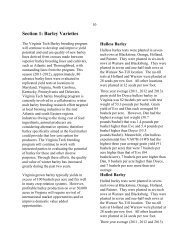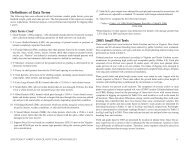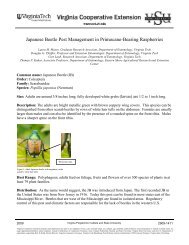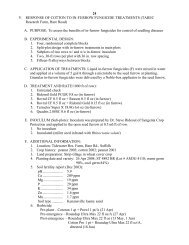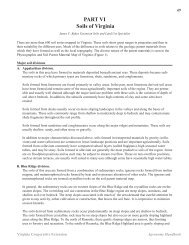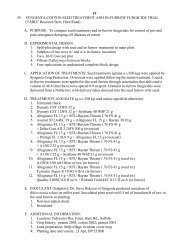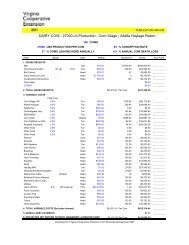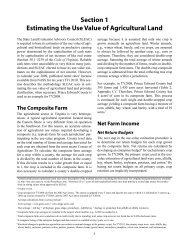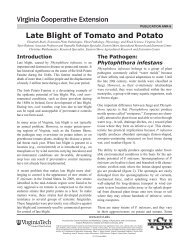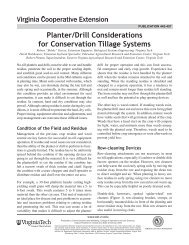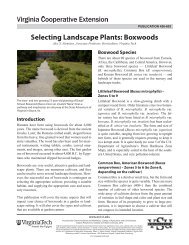PDF (1 MB) - Virginia Cooperative Extension - Virginia Tech
PDF (1 MB) - Virginia Cooperative Extension - Virginia Tech
PDF (1 MB) - Virginia Cooperative Extension - Virginia Tech
Create successful ePaper yourself
Turn your PDF publications into a flip-book with our unique Google optimized e-Paper software.
for Strawberry Anthracnose and to increase second year yields and berry size. You should<br />
understand there is a risk involved from carrying over fields due to Anthracnose, a fungus<br />
disease attacking crowns, foliage, stems, flowers and fruit of most varieties. This disease<br />
devastated and nearly ruined the North Carolina strawberry industry a few years ago when<br />
they were propagating their own plants, including some that were infected possibly at<br />
planting. There are no highly effective preventative or chemotherapy fungicides labeled for<br />
control of Anthracnose on strawberries; the only cure is to avoid the pathogen. Only healthy<br />
fields should be retained for carry-over, destroying any that the University Plant Pathology<br />
Clinic has identified as having Anthracnose on the plant parts. There is a fruit infection<br />
form of Anthracnose that has been identified in this region during harvest, but so far has not<br />
attacked plants or caused plant injury.<br />
Note: The Sweet Charlie variety is highly resistant to Strawberry Anthracnose, confirmed<br />
by Dr. Dan Legard, Strawberry Plant Pathologist at University of Florida’s Dover Research<br />
Center where Sweet Charlie was bred by Dr. Craig Chandler. So, what are the risks of your<br />
Late Star or Chandler carry-over fields getting this disease now that the industry in this area<br />
starts each planting with Anthracnose-free runner tips and plug transplants? No one can say<br />
for certain; only time will tell.<br />
Some good growers in this region have kept plantings over for the second year’s crop and<br />
even for the third year’s crop, following our renovation procedure shown in Table 11. They<br />
also report as good or even higher yields the second year, as we did in our research here.<br />
However, you may have more branch crowns on carry-over plants due to good management<br />
and favorable conditions for increased vegetative growth the previous fall and winter. Such<br />
plants need no additional branch crowns or many small berries will develop the second year!<br />
We have successfully crown-thinned with shielded sprayer and Gramoxone at renovation<br />
in late June to remove one-half of the old crown diameter growth, with no damage to the<br />
remaining unsprayed portion of the plants.<br />
Excellent new research results by our colleagues confirm these observations. Such regional<br />
research results are presented annually at The Southeast Strawberry Expo at Raleigh, North<br />
Carolina, traditionally held in early November. We hope to see each of you at this annual<br />
conference. How can you afford not to go?<br />
Growers not interested in carry-over of strawberries for the second harvest year may still be<br />
interested in other recycling double cropping possibilities: Desiccating the strawberry plants<br />
with Gramoxone after the harvest is complete, mowing off or pulling out the dead plants and<br />
replanting with vegetables such as fall pumpkins (which have been successfully field seeded<br />
and also transplanted onto the mulch film), fall tomatoes, fall cabbage, even fall cauliflower,<br />
fall broccoli, fall greens and oriental vegetables. Some successful growers have merely<br />
desiccated the old strawberry plants, mowed them down low, then planted in-between the old<br />
berry plants. Tomatoes, pumpkins and other cucurbits are planted as a single row slightly<br />
off-center to avoid hitting the drip irrigation tube. Most other vegetables are double-rowed on<br />
the old plastic mulch, either hand seeded and/or transplanted with mechanical vacuum planters<br />
and seeders developed to plant through plastic mulch. Several such planters are being used in<br />
<strong>Virginia</strong> to double crop old plastic mulched beds.<br />
19



